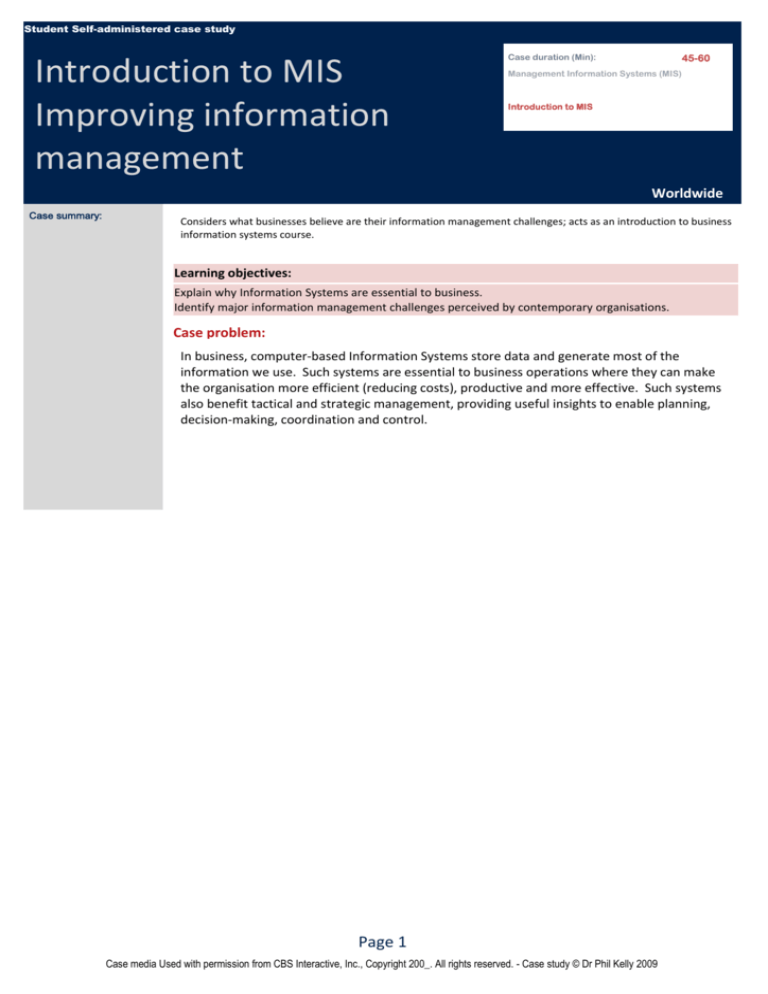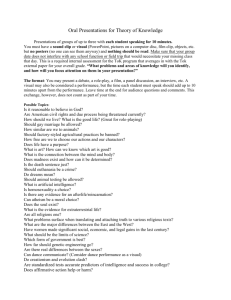
Student Self-administered case study
Introduction to MIS Improving information management
45-60
Case duration (Min):
Management Information Systems (MIS)
Introduction to MIS
Worldwide
Case summary:
Considers what businesses believe are their information management challenges; acts as an introduction to business information systems course.
Learning objectives:
Explain why Information Systems are essential to business.
Identify major information management challenges perceived by contemporary organisations.
Case problem:
In business, computer‐based Information Systems store data and generate most of the information we use. Such systems are essential to business operations where they can make the organisation more efficient (reducing costs), productive and more effective. Such systems also benefit tactical and strategic management, providing useful insights to enable planning, decision‐making, coordination and control.
Page 1
Case media Used with permission from CBS Interactive, Inc., Copyright 200_. All rights reserved. - Case study © Dr Phil Kelly 2009
First, if you are taking a taught management course then consult with your tutor and ensure that the case has not been scheduled into a teaching class or
tutorial. If it has not:
1. Play/ read the media associated with the case. You may need to access the Internet and enter a URL to locate any video clips.
2. Attempt the Case study questions.
Consider attempting the case study as a group exercise; you could form a study group with fellow students.
3. Check the suggested answers - remember these are suggestions only and there are often many possible answers.
Discuss questions and answers with other students.
4. If you feel your answer(s) were weak then consider reading the relevant suggested readings again (also see the case study suggested references).
Title/
Media type
Improving information management.
Film
URL/ Media description
http://videos.silicon.com/60438849.htm
Here Jonathan Steel, CEO of technology researchers ‐ The Bathwick Group, discusses the findings that have resulted from silicon.com's management benchmark survey. Is information management important to business and IT? Are businesses doing a good job of managing critical data? Is there anything that can be done to improve information management? Steel discusses all this and more in this video.
NOTES:
Page 2
Case media Used with permission from CBS Interactive, Inc., Copyright 200_. All rights reserved. - Case study © Dr Phil Kelly 2009
Case study questions... Pre/During/After
class
Action
1
THE PURPOSE OF INFORMATION SYSTEMS:
2
DATA AND INFORMATION:
3
WHAT IS A SYSTEM ?
4
During
List the main uses of business Information Systems.
During
The words data and information were used frequently in the film clip. Define and distinguish the two concepts
and explain what constitutes a database.
During
The terms Information Systems and business information system were used throughout the video; discuss the
meaning of these terms and concepts and list as many examples of such systems as you can.
THE IMPORTANCE AND BENEFITS OF INFORMATION SYSTEMS AND INFORMATION MANAGEMENT
IN ORGANISATIONS :
During
Drawing upon the comments made in the film clip, discuss why organisations need Information Systems and
better information management. How important are they and what benefits does the organisation gain from
them?
5
CHALLENGES:
During
What were the big issues (three most problematic issues) referred to in the film clip and what are organisations
doing to address them. You should comment on how companies are addressing their information management
issues and the barriers preventing some companies from action.
Page 3
Case media Used with permission from CBS Interactive, Inc., Copyright 200_. All rights reserved. - Case study © Dr Phil Kelly 2009
Answers... DATA
Facts or observations about physical phenomena or business transactions. More specifically, data are objective measurements of the attributes (characteristics) of entities, such as people, places, things, and events.
INFORMATION
Data that have been shaped into a form that is meaningful and useful to human beings
INFORMATION SYSTEM
(1) A set of people, procedures, and resources that collects, transforms, and disseminates information in an organization. (2) A system that accepts data resources as input and processes them into information products as output.
DATABASE
An organized collection of logically related data.
Question/ Answer
1 THE PURPOSE OF INFORMATION SYSTEMS:
List the main uses of business Information Systems.
To help with problem-solving and decision-making, to enable value adding activities, to improve
the timeliness of decisions and activities, to control and coordinate activities, to forecast and plan,
to enable the achievement of organisational goals, to increase profitability, to enable people.
2 DATA AND INFORMATION:
The words data and information were used frequently in the film clip. Define and distinguish the two concepts and explain what constitutes a database.
Data means facts or observations about physical phenomena or business transactions. more
specifically, data is objective measurement of the attributes (characteristics) of entities, such as
people, places, things, and events.
Information means data that has been processed (sorted, summarised, manipulated, filtered) so
that it is meaningful to people.
Database means a system or programme in which structured data is stored; a collection of shared,
interrelated records.
3 WHAT IS A SYSTEM ?
The terms Information Systems and business information system were used throughout the video; discuss the meaning of these terms and concepts and list as many examples of such systems as you can.
Accounting Information Systems, Enterprise information system, Executive information systems
(EIS), Geographic information system (GIS), Global information system, Human resource
information systems (HRIS), International information systems, Management Information System
(MIS), Marketing information system (MIS), Strategic information systems (SISs), customer
relationship management system, knowledge management system, materials resource planning
system, enterprise resource planning system, warehouse management system, inventory
management system, payroll system, procurement system,…
Information System means (1) a set of people, procedures, and resources that collects, transforms,
and disseminates information in an organization. (2) a system that accepts data resources as input
and processes them into information products as output. OR Information system means
interrelated components working together to collect, process, store, and disseminate information
to support decision making, coordination, control, analysis, and visualization in an organization.
Business information system refers to a specific information system used to support business;
Business information systems are information systems used to support the functional areas of
business. For example, an organization might use specialized information systems to support sales,
marketing and human resource management activities.
4 THE IMPORTANCE AND BENEFITS OF INFORMATION SYSTEMS AND INFORMATION MANAGEMENT IN Drawing upon the comments made in the film clip, discuss why organisations need Information Systems and better information management. How important are they and what benefits does the organisation gain from them?
In the video, the majority of the survey respondents considered them key to profitability and
productivity. In particular they reduce efficiency gains, driving down costs by enabling people
and business processes. They may also contribute to generating revenue by improving sales.
5 CHALLENGES:
What were the big issues (three most problematic issues) referred to in the film clip and what are organisations doing to address them. You should comment on how companies are addressing their information management issues and the barriers preventing some companies from action.
The main challenge or big issue arises because organisations typically have many different
applications/Information Systems all with their own stored data. Organisations find it difficult to
combine the data from many sources in order to provide a single operational view of what is going
on in the company. Related to this visibility problem (multiple data sources) is the problem of not
capturing all data. Both of these problems create a third problem-an inability to report properly.
Consequently, companies see a need to integrate systems i.e. create enterprise-wide systems but
these are expensive initiatives and cost may be prohibitive.
Case study references
Page 4
Case media Used with permission from CBS Interactive, Inc., Copyright 200_. All rights reserved. - Case study © Dr Phil Kelly 2009
Case study references
Cole, G A. and Kelly, P P. (2011) 'Management Theory and Practice', Ed. 7. Cengage EMEA.
Oz, E. and Jones, A. (2008) 'Management Information Systems', Ed. 1. Cengage Learning EMEA.
Stair, R M., Reynolds, G. and Chesney, T. (2008) 'Principles of Business Information Systems', Ed. 1. Cengage Learning EMEA.
Page 5
Case media Used with permission from CBS Interactive, Inc., Copyright 200_. All rights reserved. - Case study © Dr Phil Kelly 2009







